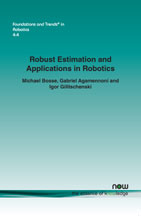Robust Estimation and Applications in Robotics
By Michael Bosse, ETH Zurich, Switzerland, mike.bosse@mavt.ethz.ch | Gabriel Agamennoni, ETH Zurich, Switzerland, gabriel.agamennoni@mavt.ethz.ch | Igor Gilitschenski, ETH Zurich, Switzerland, igilitschenski@ethz.ch
Abstract
Solving estimation problems is a fundamental component of numerous robotics applications. Prominent examples involve pose estimation, point cloud alignment, or object tracking. Algorithms for solving these estimation problems need to cope with new challenges due to an increased use of potentially poor low-cost sensors, and an ever growing deployment of robotic algorithms in consumer products which operate in potentially unknown environments. These algorithms need to be capable of being robust against strong nonlinearities, high uncertainty levels, and numerous outliers. However, particularly in robotics, the Gaussian assumption is prevalent in solutions to multivariate parameter estimation problems without providing the desired level of robustness. The goal of this tutorial is helping to address the aforementioned challenges by providing an introduction to robust estimation with a particular focus on robotics. First, this is achieved by giving a concise overview of the theory on M-estimation. M-estimators share many of the convenient properties of least-squares estimators, and at the same time are much more robust to deviations from the Gaussian model assumption. Second, we present several example applications where M-Estimation is used to increase robustness against nonlinearities and outliers.
Robust Estimation and Applications in Robotic
Solving estimation problems is a fundamental component of numerous robotics applications. Prominent examples involve pose estimation, point cloud alignment, and object tracking. Algorithms for solving these estimation problems need to cope with new challenges due to an increased use of potentially poor low-cost sensors, and an ever growing deployment of robotic algorithms in consumer products, which operate in potentially unknown environments. These algorithms need to be capable of being robust against strong nonlinearities, high uncertainty levels, and numerous outliers. However, particularly in robotics, the Gaussian assumption is prevalent in solutions to multivariate parameter estimation problems without providing the desired level of robustness.
Robust Estimation and Applications in Robotics sets out to address the aforementioned challenges by providing an introduction to robust estimation with a particular focus on robotics. It starts by providing a concise overview of the theory of M-estimation. M-estimators share many of the convenient properties of least-squares estimators, and at the same time are much more robust to deviations from the Gaussian model assumption. It goes on to present several example applications where M-Estimation is used to increase robustness against nonlinearities and outliers.
Robust Estimation and Applications in Robotics is an ideal introduction to robust statistics that only requires preliminary knowledge of probability theory. It also includes examples of robotics applications where robust statistical tools make a difference.
